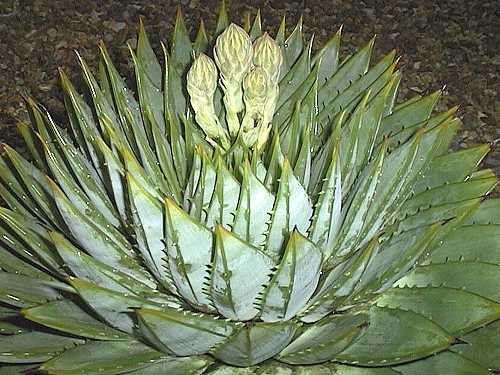 Aloe polyphylla
Aloe polyphylla
Date: 2004 May 26
See below for a few comments on seed-raising.
 Aloe polyphylla
Aloe polyphylla
Date: 2004 May 26
The "spiral Aloe of Lesotho". This is one of those plants that I had wanted to grow, but had never seen cultivated plants for sale. In late 1996, I obtained some seed from plants in cultivation in California. They germinated and grew well, and the frequent suggestions that this plant is difficult to grow appear to be unfounded.
From reading about conditions in the plant's African habitat, it seemed that at times it receives plenty water, and also is subjected to (possibly freezing) cold. The conditions in England seem to suit it, and for some years now, I have kept the plants outdoors. Mine were initially protected from rain in Winter, but a friend to whom I gave some had left one of them unprotected outside, without any ill effects (I no longer give any winter protection to my large plants).
I sold quite a lot of my seedling plants back in 1997 and subsequently, and
have sometimes seem them since being kept in a small pot in a hot greenhouse,
watered infrequently. They don't die if you do this, but they don't grow much
either!
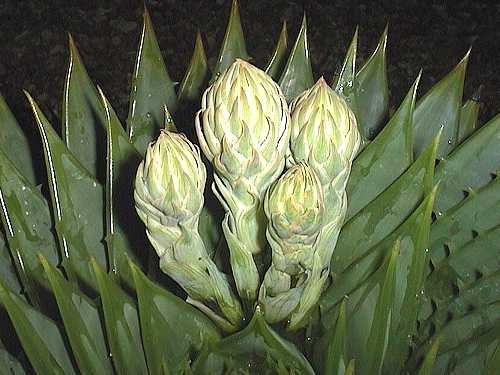
The friend who I gave some plants to first got a flower in 2002 or 2003, which is around 6 years from seed - a much shorter time than I have sometimes read.
I kept 4 of the plants myself (they get rather large - I haven't got room for more!),
and it was 2004 before one of these first flowered, as shown here. The rosette is around
50cm in diameter.
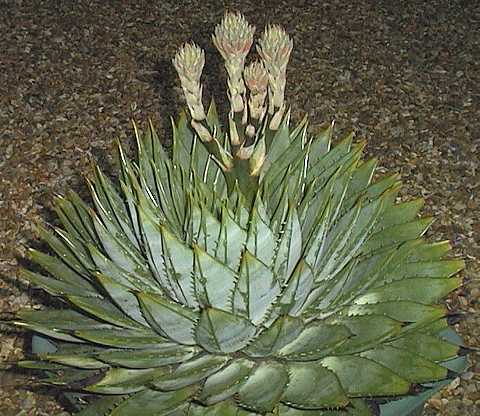
Date: 2004 June 2
The flower spike developed rapidly. You can see that in this case, the
flower stem branched into 4. My friend's two plants (a little larger, probably due
to being grown in larger containers, and with more water and richer soil) also
flowered in 2004, and had larger inflorescences with more branches.
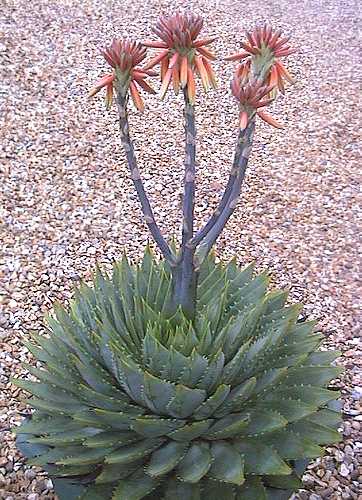
Date: 2004 June 9
The first flowers soon started to open. Each flower only lasts a few days, and appeared to be 'protandrous' (pollen ready before sigma receptive). Many trips were made carrying pollen between my plant and my friend's two plants, as it appears that the plants are usually unable to set seed unless corss-pollinated. The plant's pollinator in habitat is said to be the Malachite Sunbird - I don't know if anything is likely to pollinate the plant in England, but I was pretty sure that it wasn't going to make the 5 mile trip between the plants, so human-intervention was needed!
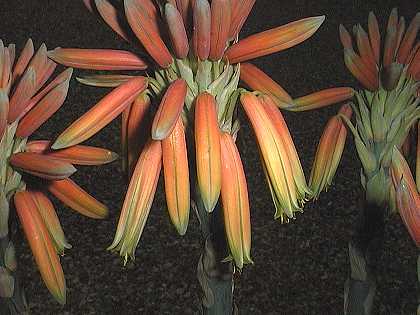
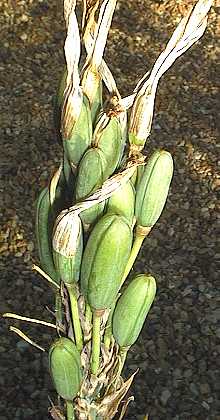
Date: 2004 July 4
As you can see, pollination appears to have been successful. I hope that these capsules ripen and contain viable seed.
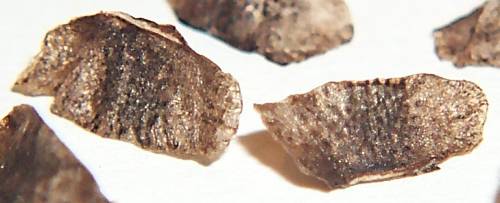
The capsules eventually split open. Having arrived back at seed again, after starting
with seed 8 years ago, I truly consider myself to have 'grown' this species.
The seeds measure around 8 x 3mm, including their papery 'wings'.
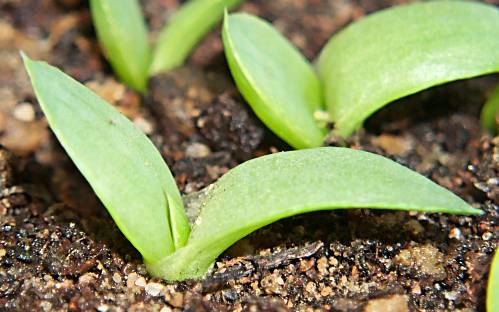
Aloe polyphylla - the next generation!
Date: 2005 February 27
I sowed some of the seed on 2005 January 16, and saw the first signs of germination 4 days later.
As typical monocotyledons, the seedlings initially produce a single leaf (the one on the right
in this photo) - I believe that this is a 'true leaf' with the actual cotyledon ('seed leaf') remaining
inside the seed-case. They grow quite quickly, and here six weeks since sowing, the 3rd leaf is starting
to appear. The seedling measures 25mm from leaf-tip to leaf-tip. The first leaves are produced
alternately opposite each other, and not until around the 7th leaf is the symmetry broken, and
the spiral arrangement (equally likely one way or the other) starts to develop.
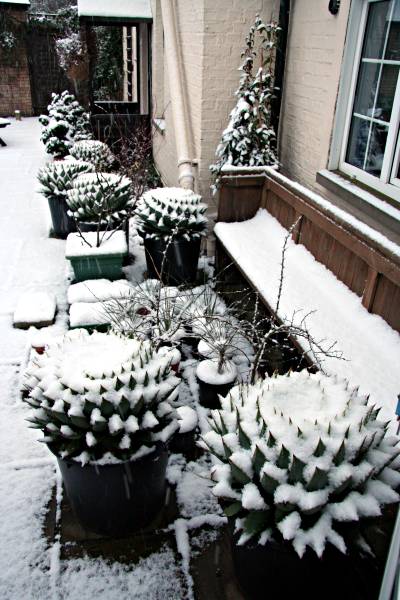
Aloe polyphylla - in the snow
Date: 2009 February 2
The story continues. 6 of my original plants raised from seed in 1996. They get no protection from the weather, even when it snows!
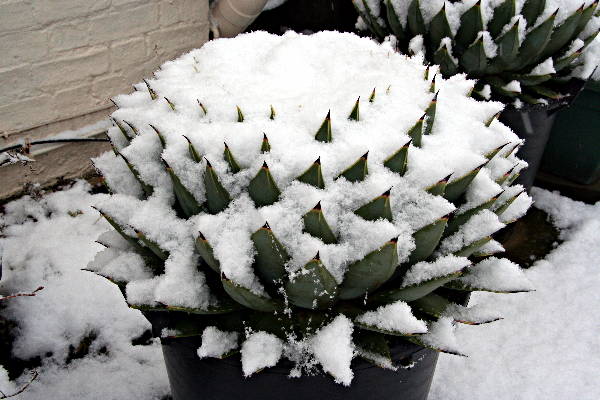
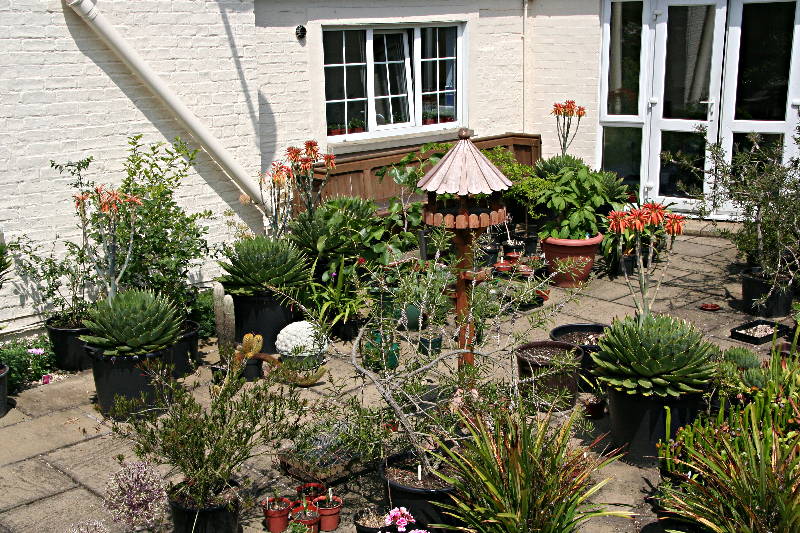
Aloe polyphylla - 7 plants, 5 flowers!
Date: 2009 June 16
The snow doesn't seem to have done any harm at all. Of the 7 large plants I ended up keeping
from seed sown in 1996, 5 of them flowered this year. I've never had more than 1 flower in any
previous year. This is probably the result of them all being re-potted 3 years ago.
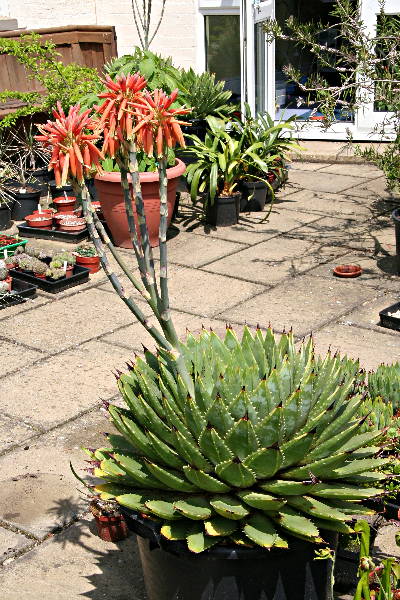
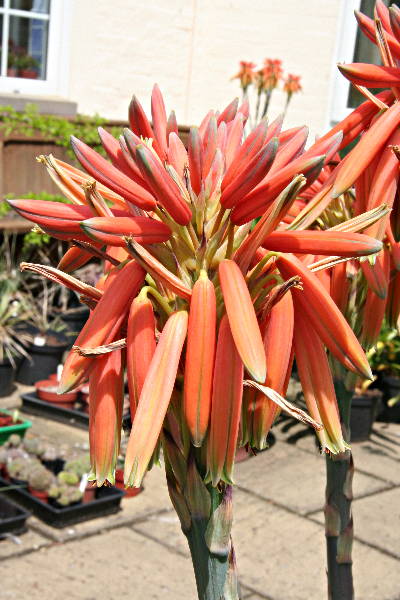
You can see the typical progression in Aloe flower spikes. The bottom flowers have already finished,
and are pointing upwards, like the eventual seed-pods do. The next ones up are open and hang downwards,
while the buds are the top, yet to open, point upwards.
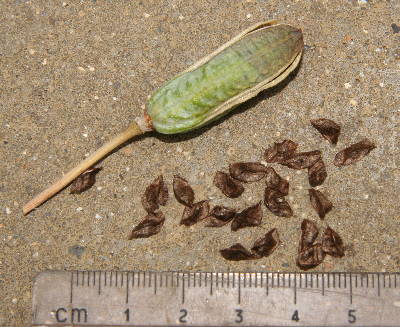 Aloe polyphylla - fruit and seeds
Aloe polyphylla - fruit and seeds
Date: 2009 August 10
With 5 flower spikes on my own plants, it was a relief for the first time not to have to transfer
pollen between my plants and a friend's ones several miles away! By August, the first fruits have
started to split open, and here is a picture of a fruit and some seeds.
I don't usually sell plants or seeds, except occasionally at 'cactus' shows or events. This is a hobby, not a business, and I haven't got time to buy a box, pack the things, take it to the post office etc.
When I first obtained seed, in 1996, I followed instructions from Alan Beverly of Ecoscape who raises the plants in California. He says to sandpaper the seed to break off the papery wings (rub seeds between two sheets of sandpaper), and then to sow normally, so this is what I'd always done, usually resulting in germination starting in a few days. I think the best germination I've had with this method is around 50%, and sometimes lower - maybe I sometimes don't sandpaper enough, or perhaps too much, though the core of the seed seems very hard and indestructible.
But by 2010, many people were saying to put the seed in water until it starts to germinate (several weeks), then to take out and sow normally. I tried this once around that time, and nothing happened - I can't remember how long I waited - perhaps not long enough.
I have previously donated some seed to the British Cactus & Succulent Society, and it appeared on their seedlist with the December 2010 journal. The accompanying article recommended soaking the seed in water until it germinates (2 weeks or more), and some people had great success with this seed. I've also donated seed in 2019, which should appear on the seedlist with the December 2019 journal, so look out for it.
I began to feel that all these people who soak seed couldn't be wrong, so in August 2013, I decided to have another attempt, using some of the old seed I have left over, collected from my own plants in 2009, 2010, and 2011 (so 2, 3, and 4 years old), which had just been stored in open containers in the house. I took about 100 of each batch of seed, and placed each batch (separately) in water. I used rain-water (not sterilised), in the house so temperature about 18C, and I changed the water every few days. I kept out of direct sunlight to avoid them getting hot, and so green algae wouldn't grow in the water. I'm not claiming that these details are important - they just happen to be what I did. The seed floats to start with, but sinks after a few days. Every few days after the seeds started to germinate (which they did, after about 28 days in the water), I removed those that had germinated, and placed in soil - usually root was just showing, or was up to about the length of the seed. I found it easy just to tip water and seeds onto a flat tray; pour off the water; the germinating seeds would stick to either my finger or the blade of a penknife and could be shaken off onto the soil. Once I'd got all the germinating ones, I just washed the remaining seed back off the tray into their jar of water.
Here are the results - what total percentage of each batch of seeds had germinated by various numbers of days since putting in water on 2013 August 15:
| 4 years old | 3 years old | 2 years old | |
|---|---|---|---|
| 28 days | 4% | 1% | 9% |
| 36 days | 20% | 5% | 30% |
| 41 days | 36% | 21% | 51% |
| 44 days | 51% | 31% | 58% |
| 48 days | 64% | 48% | 71% |
| 52 days | 75% | 67% | 80% |
| 61 days | 81% | 80% | 83% |
So conclusions: the 'soak in water' method does indeed work, and seed doesn't have to be very fresh or be stored in special conditions.
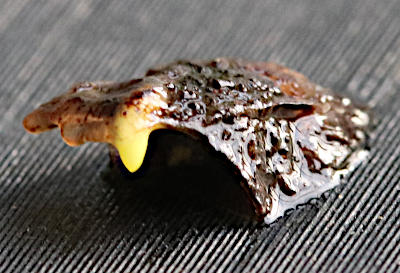 Aloe polyphylla - germinating seed
Aloe polyphylla - germinating seed
Date: 2020 January 27
Here is an Aloe polyphylla seed germinating after 10 days soaking in water. This seed is one from 50 from the batch
which I donated to the December 2019 BCSS seedlist. It was in rainwater straight from the water-butt,
at about 18 degrees C, and in the light, though I'm not saying that these details were important. If I was going to
transfer this to soil at this stage, I'd just slightly cover the emerging root, but I'm going to wait until this one
has made more progress, and maybe some others have germinated. The point from which the first leaf will emerge is not yet
visible - it will be close to the point where the root enters the seed.
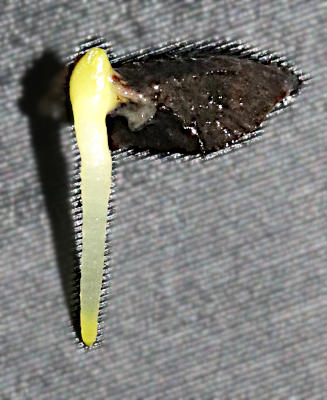 Aloe polyphylla - germinating seed
Aloe polyphylla - germinating seed
Date: 2020 January 30
Here is the same germinating seed as above, but 3 days later, so after 13 days soaking in water. None of the
other seeds in the batch of 50 have yet germinated. The root has continued to grow and now the first leaf is
starting to develop at the top. Size at this stage is 8mm from tip to tip. At this stage, I planted the seedling
in soil, just leaving the developing leaf exposed. I would have done it sooner apart from wanting to take the
photo, as the longer the root gets, the more chance of damaging it while getting out of the water and planting.